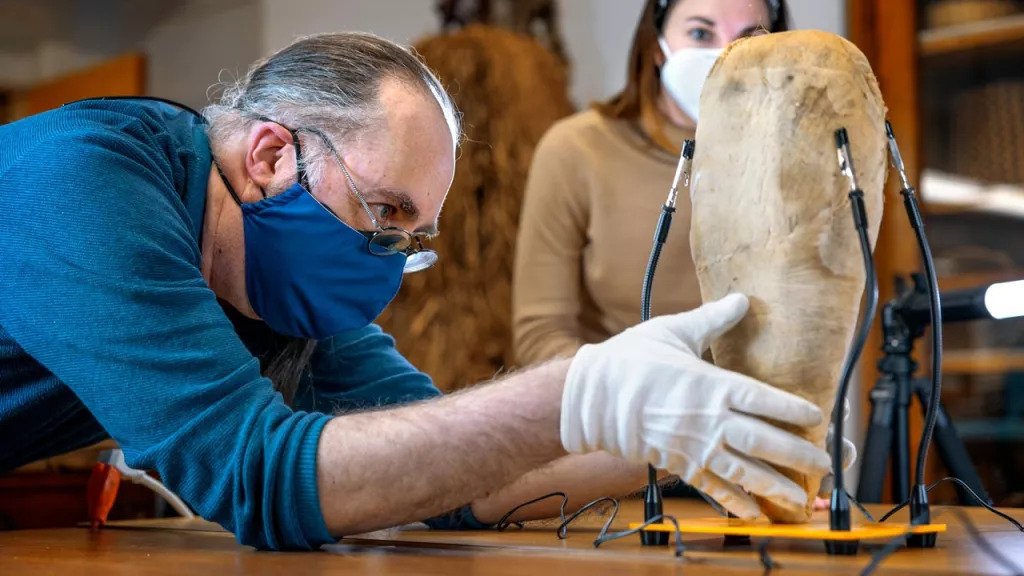An ancient Egyptian mummy forgotten in storage turns out to be a sacred bird often sacrificed to Thoth
An ancient Egyptian bird mummy, long forgotten in storage and mislabeled as a hawk, is finally getting its due now that researchers have digitally peered inside its wrappings.

The 1,500-year-old mummy, scientists learned, is not a hawk but likely a sacred ibis (Threskiornis aethiopica) — a wading bird with stilt-like legs and a long curved beak that the ancient Egyptians often sacrificed to Thoth, the god of the moon, reckoning, learning and writing.
“Not only was this once a living creature that people of the day may have enjoyed watching stroll through the water,” Carol Ann Barsody, a master’s student in archaeology at Cornell University, who spearheaded the project, said in a statement. “It also was, and is, something sacred, something religious.”
Cornell University has no record of the mummy’s arrival into its collections. Barsody initially suspected that the mummy arrived as part of an 1884 freight of objects, which included the human mummy Penpi, a Thebian scribe. However, after doing further research, she discovered that no other Egyptian artefacts arrived with Penpi.
Barsody now believes the mummy to have been part of a 1930 donation by Cornell alumnus John Randolph, but she is still playing detective to determine the mummy’s true origins.
Barsody worked at Cornell as an employee at the Center for Technology licensing and, while pursuing her degree in archaeology, became interested in the mummy as a case study for how technology could be used to unwrap the mystery.
Barsody decided to learn all she could about the mummy without disturbing the animal inside. Along with Frederic Gleach, a senior lecturer and curator of Cornell’s Anthropology Collections, she took the mummy to the College of Veterinary Medicine where the lightweight 2-pound (942 grams) mummy underwent a CT scan in order to determine that it was, in fact, a bird.
The scan revealed that a leg had been fractured prior to the mummification process and that feathers and soft tissue were still preserved. They were also able to discern that the bird’s broken beak had occurred post mummification.
The pair then consulted Vanya Rohwer, the curator of Birds and Mammals at the Cornell Museum of Vertebrates who identified the remains as those of an ibis. This wasn’t too surprising, as ibises in ancient Egypt were bred in large numbers due to their popularity, particularly in their use as offerings.
Initially, this particular mummy perplexed the team because of the way the ancient Egyptians had prepared the bird. When examining the CT scan, they were unable to see how the bird had been folded into its current shape. It was only when using the museum’s collection of study skins and skeletons, carefully copying the bird’s shape by fitting pieces together, that they were able to conclude that the ibis’s head had been twisted around and bent back against its body.
The sternum and ribcage had also been removed — a practice that isn’t common among bird mummifications.
The ibis was a bird that originated in Africa and was venerated not only in ancient Egypt but also in Greece and Rome, according to AviBirds. Thoth was regularly depicted as having a human body and the long-beaked head of a bird. Millions of ibises have been found in Egyptian necropolises, according to a 2019 study published by the journal Plos One.
Currently, Barsody is working with Jack Defay, an electrical and computer engineering student at Cornell, to scan the mummy in order to construct a virtual 3D model of the bird.
This bird has “had multiple lives,” Barsody said. “I look at what I’m doing as another form of extending its incredible life.”
Barsody will soon launch a website, www.birdmummy.com, which will focus on using the mummy in order to increase the museum’s educational outreach. She also plans to open an exhibition of the bird, its 3D model and a hologram at the Herbert F. Johnson Museum of Art at Cornell in October.





